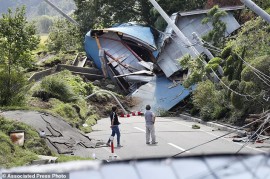
It has been a shaky year for 2018 so far and Geologists predicted the earth could see about twice as many major earthquakes this year than in 2017, after assessment of the earth’s movement data that showed a slowdown in the earth’s rotation[1]. The earth-slowing phenomena prompted equator to shrink slightly. As a result, the edges of tectonic plates squeeze together causing more earthquakes. Here are five major earthquakes this year:
Hokkaido Japan Earthquake
Date: September
Area: Northern Japanese Island of Hokkaido
Death Toll: 40+
Cause and Damage: The magnitude 6.7 earthquake struck before daybreak of 6 September and knocked out power and train service across Hokkaido, home to 5.4 million people. Nearly 3 million households lost power, according to the Hokkaido Electric Power Company. It took two days to restore electricity to most households.
Source: https://www.washingtonpost.com/world/asia_pacific/
Lombok Indonesia Earthquakes
Dated: July and August
Area: Lombok, Indonesia
Death Toll: 500+
Cause and Damage: A destructive and shallow earthquake of 6.9 magnitude struck the island of Lombok, Indonesia. It was the main shock following its foreshock, a nearby Mw 6.4 earthquake on 29 July and was followed by another 6.9 earthquake on 19 August 2018. The epicenter was located inland, near Loloan Village in North Lombok Regency. Its rupture spread to the north and reached the sea, creating tsunamis. Severe shaking was reported throughout the entire island, while strong shaking was reported on the neighboring islands of Bali and Sumbawa.
Source: https://reliefweb.int/disaster/eq-2018-000122-idn
Fiji Earthquake
Dated: August
Area: Ndoi Island, Fiji
Death Toll: Not reported
Cause and Damage: A 7.9 magnitude earthquake has struck the holiday island of Fiji in August. The quake was centered about 281km north of Ndoi Island with a depth of 559.6km.
Source: https://www.news.com.au/travel/travel-updates/incidents/massive-earthquake-rocks-fiji/news-story/0b35939ce91a9117cb41bb772c6a4c90
Oaxaca Mexico Earthquake
Dated: February
Area: Oaxaca, Mexico
Death Toll: 14+
Cause and Damage: The 2018 Oaxaca earthquake of 7.2 magnitude occurred in the Sierra Madre del Sur in Oaxaca state in Southern Mexico. The hypocenter was located at a depth of 24.6 km and approximately 37 km northeast of Pinotepa de Don Luis. Oaxaca lies on the destructive plate boundary where the Cocos Plate is being subducted beneath the North American Plate. In the region of this earthquake, the Cocos Plate moves approximately northeastward at a rate of 60 mm/yr. The earthquake occurred as a result of thrust faulting at a shallow depth. The helicopter was also crashed during the earthquake.
Source: https://en.wikipedia.org/wiki/2018_Oaxaca_earthquake
Papua New Guinea earthquake
Dated: February
Area: Hela Province, Papua New Guinea
Death Toll: 160+
Cause and Damage: A 7.5 magnitude earthquake occurred in Hela Province, Papua New Guinea and the epicenter was 10 kilometres (6.2 mi) west of the town of Komo. Papua New Guinea lies within the complex zone of collision between the Australian Plate and the Pacific Plate, which converge at a rate of 107 mm per year at the earthquake’s location. An assessment have shown significant damage and large landslides, and it is estimated that up to 465,000 people may have been affected by the disaster. A major aftershock with a magnitude of 6.2 M occurred in the Southern Highlands province close to the location of the earthquake.
Source: https://reliefweb.int/disaster/eq-2018-000020-png
Earthquakes cannot be prevented and sometimes are predicted incorrectly. But the effects of earthquakes particularly for infrastructure can be reduced by having innovative structural systems. These systems, however, require practicing engineers to have great expertise, skills, and computational capabilities. To address the issues related to safety of cities and infrastructure, the 7th Asia Conference on Earthquake Engineering (7ACEE2018) is being jointly organized by the Asian Institute of Technology (AIT) and Engineering Institute of Thailand (EIT) in collaboration with the Association of Structural Engineers of the Philippines, Inc. (ASEP) and supported by Computers and Structures, Inc.(CSI), European Union, and Mahidol University. The Conference will be held at Sheraton Grande Sukhumvit, Bangkok, Thailand from 22-25 November 2018.
Registration for this conference is still open. Be sure to register at http://acee2018.org/ or contact aceesecretariat@ait.asia for more info.
[1] Source: https://www.businessinsider.com/earthquakes-global-seismic-hazard-slow-earth-rotation-2017-11
Photo credit: Associated Press Photos

